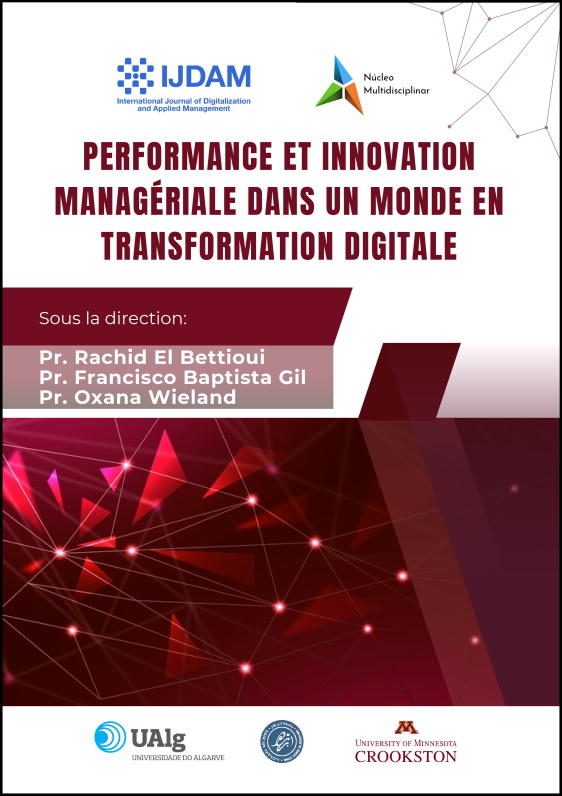Quantitative Study of Technological Determinants of Generative AI Acceptability Among Chartered Accountants in Morocco
DOI:
https://doi.org/10.23882/ijdam.25173Keywords:
Generative AI, technological acceptability, chartered accountancy, ergonomics, MoroccoAbstract
This work aims to identify and analyze the technological determinants of generative artificial intelligence acceptability among Moroccan chartered accountants. With the emergence of these technologies transforming professional practices, our study specifically examines the influence of technological factors on their acceptance. Our methodology is based on a quantitative approach involving 262 chartered accountants registered with the Moroccan Institute of Chartered Accountants. Three technological determinants were examined: perceived ease of use, perceived usefulness, and anthropomorphism. The results reveal that ease of use is the predominant factor (β=0.390, p<0.001), followed by perceived usefulness, which exerts a moderate but significant influence (β=0.170, p<0.01). Contrary to theoretical expectations, anthropomorphism shows no significant effect (β=0.087, p>0.05). This study demonstrates that the acceptability of generative AI is primarily based on ergonomic considerations rather than relational or anthropomorphic aspects. These findings suggest the importance of prioritizing ease of use and accessibility in developing AI solutions for accounting professionals.
References
Askell, A. et al. (2021). A General Language Assistant as a Laboratory for Alignment. https://doi.org/10.48550/arXiv.2112.00861
Bartneck, C., Kulić, D., Croft, E., & Zoghbi, S. (2009). Measurement Instruments for the Anthropomorphism, Animacy, Likeability, Perceived Intelligence, and Perceived Safety of Robots. International Journal of Social Robotics, 1(1), 71-81. https://doi.org/10.1007/s12369-008-0001-3
Bartlett, M. S. (1954). A note on the multiplying factors for various chi square approximations. Journal of the Royal Statistical Society, 16(Series B), 296-298.
Benbasat, I., & Barki, H. (2007). Quo vadis TAM? Journal of the Association for Information Systems, 8(4), 211-218. https://doi.org/10.17705/1jais.00126
Blut, M., Wang, C., Wünderlich, N. V., & Brock, C. (2021). Understanding anthropomorphism in service provision: a meta-analysis of physical robots, chatbots, and other AI. Journal of the Academy of Marketing Science, 49(4), 632-658. https://doi.org/10.1007/s11747-020-00762-y
Chin, W. W. (1998). The partial least squares approach to structural equation modeling. Modern Methods for Business Research, 295(2), 295-336.
Churchill, G. A. (1979). A paradigm for developing better measures of marketing constructs. Journal of Marketing Research, 16(1), 64-73. https://doi.org/10.2307/3150876
Clark, L. A., & Watson, D. (1995). Constructing validity: Basic issues in objective scale development. Psychological Assessment, 7(3), 309-319. https://doi.org/10.1037/1040-3590.7.3.309
Cohen, J. (1988). Statistical power analysis for the behavioral sciences (2nd ed.). Lawrence Erlbaum Associates.
Damerji, H., & Salimi, A. (2021). Mediating effect of use perceptions on technology readiness and adoption of artificial intelligence in accounting. Accounting Education, 30(2), 107-130. https://doi.org/10.1080/09639284.2021.1872036
Davis, F. D. (1989). Perceived usefulness, perceived ease of use, and user acceptance of information technology. MIS Quarterly, 13(3), 319-340. https://doi.org/10.2307/249008
Davis, F. D., Bagozzi, R. P., & Warshaw, P. R. (1989). User acceptance of computer technology: a comparison of two theoretical models. Management Science, 35(8), 982-1003. https://doi.org/10.1287/mnsc.35.8.982
Feuerriegel, S., Hörchler, L., Kühl, N., & Seyfried, F. (2024). Changing the economics of content production: A research agenda on text-generating AI. Information Systems Research. https://doi.org/10.1287/isre.2023.0214
Fornell, C., & Larcker, D. F. (1981). Evaluating structural equation models with unobservable variables and measurement error. Journal of Marketing Research, 18(1), 39-50. https://doi.org/10.2307/3151312
Gotthardt, M., Koivulaakso, D., Paksoy, O., Saramo, C., Martikainen, M., & Lehner, O. (2020). Current state and challenges in the implementation of smart robotic process automation in accounting and auditing. ACRN Journal of Finance and Risk Perspectives, 9(1), 90-102. https://doi.org/10.35944/jofrp.2020.9.1.007
Gursoy, D., Chi, O. H., Lu, L., & Nunkoo, R. (2019). Consumers acceptance of artificially intelligent (AI) device use in service delivery. International Journal of Information Management, 49, 157-169. https://doi.org/10.1016/j.ijinfomgt.2019.03.008
Hair, J. F., Hult, G. T. M., Ringle, C. M., & Sarstedt, M. (2017). A primer on partial least squares structural equation modeling (PLS-SEM) (2nd ed.). Sage.
Hair, J. F., Hult, G. T. M., Ringle, C. M., & Sarstedt, M. (2019). A primer on partial least squares structural equation modeling (PLS-SEM) (3rd ed.). Sage.
Hair, J. F., Ringle, C. M., & Sarstedt, M. (2011). PLS-SEM: Indeed a silver bullet. Journal of Marketing Theory and Practice, 19(2), 139-152. https://doi.org/10.2753/MTP1069-6679190202
Hair, J. F., Risher, J. J., Sarstedt, M., & Ringle, C. M. (2022). The meta-analysis of partial least squares structural equation modeling (PLS-SEM) results in accounting research. Journal of International Financial Management & Accounting, 33(2), 182-211. https://doi.org/10.1111/jifm.12156
Hanetseder, C., Schulte-Nölke, H., & Amarouch, F. (2021). Digitalisierung in der Finanzbuchhaltung und die Zukunft des Berufsstandes. Der Betrieb, 74(19), 1017-1022.
Henseler, J., Ringle, C. M., & Sarstedt, M. (2015). A new criterion for assessing discriminant validity in variance-based structural equation modeling. Journal of the Academy of Marketing Science, 43(1), 115-135. https://doi.org/10.1007/s11747-014-0403-8
Kaiser, H. F. (1974). An index of factorial simplicity. Psychometrika, 39(1), 31-36. https://doi.org/10.1007/BF02291575
KEBE, P. I., El Bettioui, R., & COMBAUDON , C. (2024). L’évaluation de la performance des projets de R&D de la logique d’efficacite economique a la logique institutionnelle: Cas d’une entreprise énergétique. IJDAM • International Journal of Digitalization and Applied Management, 1(2), 92–120. https://doi.org/10.23882/ijdam.24134
Lee, J. D., & See, K. A. (2004). Trust in automation: Designing for appropriate reliance. Human Factors, 46(1), 50-80. https://doi.org/10.1518/hfes.46.1.50_30392
Manita, R., Elommal, N., Baudier, P., & Hikkerova, L. (2020). The digital transformation of external audit and its impact on corporate governance. Technological Forecasting and Social Change, 150, 119751. https://doi.org/10.1016/j.techfore.2019.119751
Nunnally, J. C. (1978). Psychometric theory (2nd ed.). McGraw-Hill.
Ordre des Experts-Comptables du Maroc [OEC]. (2024). Annuaire des experts-comptables inscrits au tableau de l'Ordre. Récupéré le 12/08/2024 de https://jecherchemonexpertcomptable.oecmaroc.com/
Parasuraman, R., Sheridan, T. B., & Wickens, C. D. (2008). Situation awareness, mental workload, and trust in automation: Viable, empirically supported cognitive engineering constructs. Journal of Cognitive Engineering and Decision Making, 2(2), 140-160. https://doi.org/10.1518/155534308X284417
Rocchetta, S. (2024). Resilience and Innovation: A Conceptual Approach. In Innovation-Research and Development for Human, Economic and Institutional Growth. IntechOpen. https://doi.org/10.5772/intechopen.113842
Shanahan, M. (2024). Talking About Large Language Models. arXiv preprint arXiv:2212.03551.
Sharma, K., Sharma, R., & Sharma, S. (2021). Technology acceptance model for the use of artificial intelligence in accounting and auditing: A conceptual framework. Journal of Management Information and Decision Sciences, 24(8), 1-13.
Siau, K., & Wang, W. (2018). Building trust in artificial intelligence, machine learning, and robotics. Cutter Business Technology Journal, 31(2), 47-53.
Skidmore, S. M., & Smith, S. D. (2024). Impact of Generative Artificial Intelligence on Accounting and Financial Reporting. The CPA Journal, 94(1), 75-85.
Stone, M. (1974). Cross-validatory choice and assessment of statistical predictions. Journal of the Royal Statistical Society: Series B (Methodological), 36(2), 111-133. https://doi.org/10.1111/j.2517-6161.1974.tb00994.x
Touvron, H., Lavril, T., Izacard, G., Martinet, X., Lachaux, M. A., Lacroix, T., ... & Lample, G. (2023). LLaMA: Open and efficient foundation language models. arXiv preprint arXiv:2302.13971.
Vărzaru, A. A. (2022). Perceptions of accountants regarding artificial intelligence use in management accounting. Journal of Accounting and Management Information Systems, 20(4), 709-736. https://doi.org/10.24818/jamis.2021.04005
Venkatesh, V., & Bala, H. (2008). Technology acceptance model 3 and a research agenda on interventions. Decision Sciences, 39(2), 273-315. https://doi.org/10.1111/j.1540-5915.2008.00192.x
Venkatesh, V., & Davis, F. D. (2000). A theoretical extension of the technology acceptance model: Four longitudinal field studies. Management Science, 46(2), 186-204. https://doi.org/10.1287/mnsc.46.2.186.11926
Venkatesh, V., Morris, M. G., Davis, G. B., & Davis, F. D. (2003). User acceptance of information technology: Toward a unified view. MIS Quarterly, 27(3), 425-478. https://doi.org/10.2307/30036540
Venkatesh, V., Thong, J. Y., & Xu, X. (2012). Consumer acceptance and use of information technology: extending the unified theory of acceptance and use of technology. MIS Quarterly, 36(1), 157-178. https://doi.org/10.2307/41410412
Waytz, A., Cacioppo, J., & Epley, N. (2010). Who sees human? The stability and importance of individual differences in anthropomorphism. Perspectives on Psychological Science, 5(3), 219-232. https://doi.org/10.1177/1745691610369336
Waytz, A., Heafner, J., & Epley, N. (2017). The mind in the machine: Anthropomorphism increases trust in an autonomous vehicle. Journal of Experimental Social Psychology, 52, 113-117. https://doi.org/10.1016/j.jesp.2014.01.005
Downloads
Published
How to Cite
Issue
Section
License
Copyright (c) 2025 Abdellatif AZIKI, Moulay Hachem FADILI, Rachid EL BETTIOUI

This work is licensed under a Creative Commons Attribution-NonCommercial 4.0 International License.















